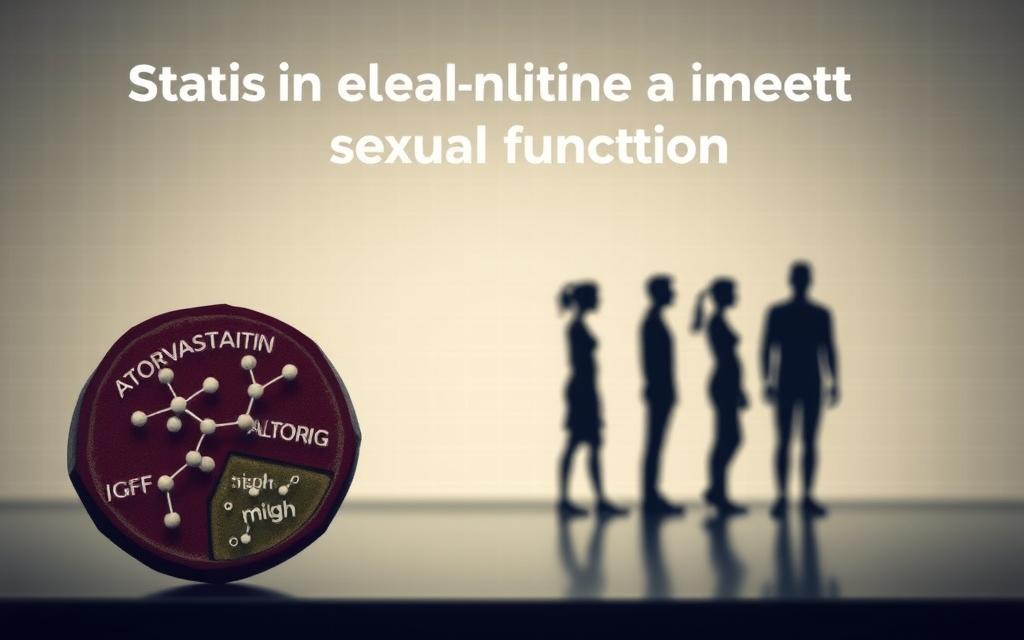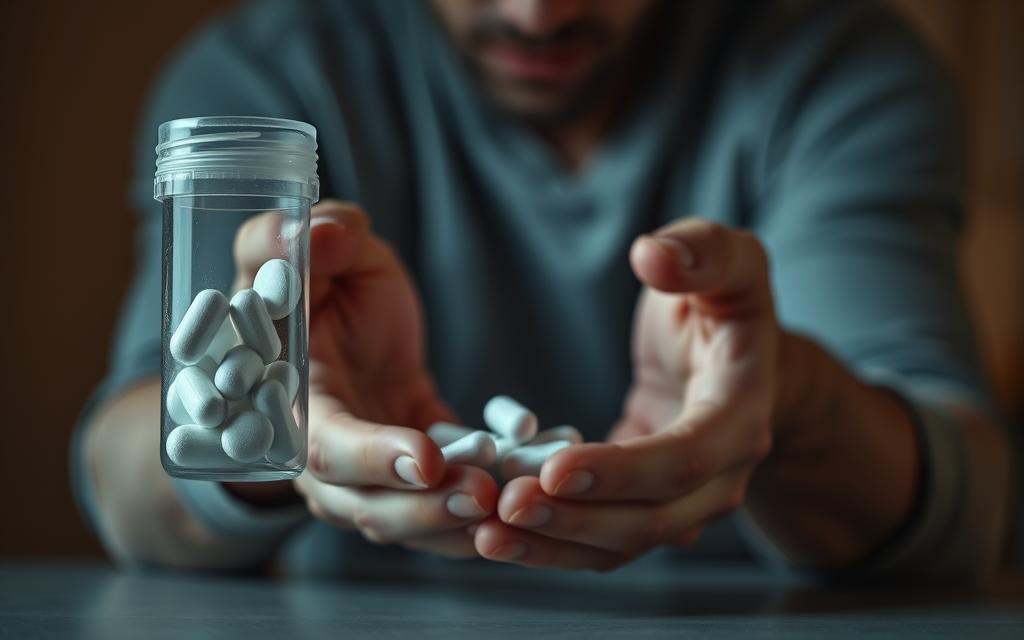Does Atorvastatin Cause Erectile Dysfunction? Find Out Here
Concerns about the potential side effects of cholesterol medication, particularly atorvastatin, have been on the rise. One of the most pressing questions is whether this commonly prescribed statin can lead to erectile dysfunction.
Atorvastatin is widely used to lower cholesterol levels and prevent cardiovascular disease. However, some individuals taking this medication have reported experiencing sexual health issues, sparking a debate about its impact on erectile function.
Understanding the relationship between cholesterol medication and sexual health is crucial for individuals relying on these drugs to manage their heart health. This article aims to explore the available evidence and expert opinions on whether atorvastatin can cause erectile dysfunction.
Understanding Atorvastatin: A Cholesterol-Lowering Medication
To understand the potential effects of atorvastatin on erectile function, it’s essential to first grasp what atorvastatin is and how it works. Atorvastatin is a medication that belongs to the statin class of drugs, widely prescribed to manage high cholesterol levels and prevent cardiovascular disease.
What Is Atorvastatin and How Does It Work?
Atorvastatin functions by inhibiting the enzyme HMG-CoA reductase, which plays a crucial role in the production of cholesterol in the liver. By reducing the liver’s ability to produce cholesterol, atorvastatin lowers the overall levels of low-density lipoprotein (LDL) cholesterol, or “bad” cholesterol, in the blood.
Mechanism of Action in the Body
The mechanism of action of atorvastatin involves the inhibition of HMG-CoA reductase, leading to a decrease in the synthesis of cholesterol in the liver. This results in an increase in the number of LDL receptors on the surface of liver cells, enhancing the clearance of LDL cholesterol from the bloodstream. This dual action effectively reduces the amount of LDL cholesterol circulating in the blood.
Typical Dosages and Administration
Atorvastatin is administered orally, typically once daily, with dosages ranging from 10 mg to 80 mg, depending on the patient’s condition and response to treatment. The dosage is often adjusted based on the patient’s LDL cholesterol levels and other factors such as potential side effects. It’s crucial to follow the prescribed dosage and administration guidelines to maximize the benefits of atorvastatin while minimizing potential side effects.
Common Uses and Benefits of Atorvastatin
Atorvastatin is primarily used to treat high cholesterol and prevent cardiovascular disease. Its benefits include reducing the risk of heart attacks, strokes, and other cardiovascular events. The table below summarizes the key benefits and common uses of atorvastatin.
| Condition | Benefit |
|---|---|
| High Cholesterol | Reduces LDL cholesterol levels |
| Cardiovascular Disease | Prevents heart attacks and strokes |
| Familial Hypercholesterolemia | Manages genetic condition causing high cholesterol |
Erectile Dysfunction: Causes and Risk Factors
Erectile dysfunction is a complex condition with multiple causes and risk factors that can vary from one individual to another. Understanding these factors is essential for effective management and treatment.
Defining Erectile Dysfunction
Erectile dysfunction (ED) is characterized by the inability to achieve or maintain an erection sufficient for satisfactory sexual performance. It’s a common condition that affects men of all ages, but its prevalence increases with age.
Common Causes of ED
The causes of ED can be broadly categorized into physical and psychological factors.
Physical Causes
Physical causes of ED include cardiovascular disease, diabetes, obesity, and certain medications. These conditions can damage blood vessels and nerves, impairing erectile function.
Psychological Causes
Psychological factors, such as stress, anxiety, and depression, can also contribute to ED. These conditions can affect a man’s ability to achieve or maintain an erection.
Risk Factors That Increase the Likelihood of ED
Several risk factors can increase the likelihood of developing ED. These include:
- Age
- Smoking
- Obesity
- Lack of physical activity
- Certain medical conditions, such as hypertension and diabetes
Understanding these risk factors can help men take preventive measures and seek medical attention if symptoms persist.
The Relationship Between Cholesterol and Sexual Function
Cholesterol, often discussed in the context of heart health, also plays a significant role in sexual function. The relationship between cholesterol levels and sexual health is complex, involving various physiological mechanisms that affect overall wellbeing.
How Cholesterol Affects Blood Flow
Cholesterol levels can significantly impact blood flow, a critical factor in sexual function. High levels of low-density lipoprotein (LDL) cholesterol can lead to the narrowing of blood vessels, reducing blood flow to the genital area and potentially impairing sexual function. Maintaining healthy cholesterol levels is essential for ensuring proper blood flow and overall cardiovascular health.
The Connection Between Cardiovascular Health and Sexual Function
Cardiovascular health is closely linked to sexual function. Conditions that affect the heart and blood vessels, such as atherosclerosis, can also impact sexual performance. Endothelial function, which refers to the health of the inner lining of blood vessels, plays a crucial role in both cardiovascular and sexual health.
Endothelial Function and Erectile Health
The endothelium produces nitric oxide, a key molecule involved in the relaxation of smooth muscle and the dilation of blood vessels. Healthy endothelial function is vital for achieving and maintaining an erection. Factors that impair endothelial function, such as high cholesterol and smoking, can contribute to erectile dysfunction.
Atherosclerosis and Its Impact on Sexual Performance
Atherosclerosis, or the buildup of plaque in the arteries, can restrict blood flow to the penis, leading to erectile dysfunction. Managing cholesterol levels and maintaining cardiovascular health are crucial for preventing atherosclerosis and its impact on sexual performance.
- High cholesterol can impair blood flow, affecting sexual function.
- Cardiovascular health is closely linked to sexual health.
- Maintaining healthy cholesterol levels is vital for overall wellbeing.
Does Atorvastatin Cause Erectile Dysfunction? Examining the Evidence
Clinical evidence regarding the relationship between atorvastatin and erectile dysfunction is mixed and warrants closer examination. To understand whether atorvastatin causes ED, it’s essential to review clinical studies and statistical data on reports of ED associated with atorvastatin use.
Clinical Studies on Statins and Sexual Function
Numerous studies have investigated the impact of statins, including atorvastatin, on sexual function. Some research suggests that statins may have a negative effect on erectile function, while other studies have found no significant association.
Meta-Analyses and Their Findings
Meta-analyses of statin trials have provided insights into the potential effects of statins on sexual function. A meta-analysis published in the Journal of Clinical Hypertension found that statins were associated with a slight increase in the risk of ED. However, the overall evidence is not conclusive, and more research is needed.
Limitations of Current Research
While existing studies provide valuable information, they have several limitations. Many studies rely on self-reported data, which can be subject to bias. Additionally, the duration of many studies is relatively short, making it difficult to assess long-term effects.
Statistical Data on Atorvastatin and ED Reports
Statistical analysis of adverse event reports can provide insights into the potential association between atorvastatin and ED. The FDA Adverse Event Reporting System (FAERS) is a valuable resource for such data.
| Year | Number of ED Reports | Total Atorvastatin Reports | Percentage of ED Reports |
|---|---|---|---|
| 2018 | 542 | 23,419 | 2.31% |
| 2019 | 578 | 25,103 | 2.30% |
| 2020 | 612 | 26,819 | 2.28% |
FDA Adverse Event Reporting System Data
The FAERS data indicates that ED reports associated with atorvastatin have remained relatively stable over the past few years, constituting approximately 2.3% of all atorvastatin-related reports.
Comparison to Background Rates of ED
Comparing the rate of ED reports among atorvastatin users to the background rate of ED in the general population is crucial. Studies suggest that the prevalence of ED among men taking atorvastatin is not significantly higher than in the general population of similar age and health status.
Potential Mechanisms: How Atorvastatin Might Affect Sexual Function
The impact of atorvastatin on sexual function is a complex issue that involves multiple physiological pathways. Atorvastatin, like other statins, is prescribed to lower cholesterol levels and reduce the risk of cardiovascular disease. However, its effects on sexual function have been a subject of research and debate.
Impact on Testosterone Levels
Atorvastatin may affect testosterone levels, which are crucial for sexual function. Research on statin effects on hormone production has yielded mixed results.
Research on Statin Effects on Hormone Production
Some studies suggest that statins, including atorvastatin, can decrease testosterone levels by inhibiting the production of cholesterol, a precursor to steroid hormones. A study published in the Journal of Clinical Endocrinology and Metabolism found that statin therapy was associated with reduced testosterone levels in men.
Individual Variability in Hormonal Response
It’s essential to note that individual responses to statin therapy can vary significantly. Factors such as dosage, duration of treatment, and individual health conditions can influence how atorvastatin affects testosterone levels.
Effects on Nitric Oxide Production
Nitric oxide plays a critical role in erections by relaxing smooth muscle and improving blood flow to the penis.
The Role of Nitric Oxide in Erections
Nitric oxide is a key mediator of erectile function. It is released by the endothelial cells lining the blood vessels and cavernous smooth muscle, leading to vasodilation and increased blood flow.
How Statins May Influence This Pathway
Statins, including atorvastatin, may influence nitric oxide production by improving endothelial function. Research suggests that statins can enhance nitric oxide availability by reducing oxidative stress and inflammation.
| Mechanism | Effect on Sexual Function | Relevant Study Findings |
|---|---|---|
| Impact on Testosterone | Potential decrease in testosterone levels | Reduced testosterone in men on statin therapy |
| Effects on Nitric Oxide | Improvement in nitric oxide availability | Enhanced endothelial function, reduced oxidative stress |
Other Statin Medications and Their Impact on Sexual Function
Statins, as a class of drugs, are not created equal when it comes to their potential impact on sexual function. While atorvastatin is widely prescribed, other statins may have different effects on erectile dysfunction (ED).

Comparing Atorvastatin to Other Statins
Atorvastatin is often compared to other statins like simvastatin, rosuvastatin, and pravastatin in terms of efficacy and side effects. Lipophilic statins, such as simvastatin, can penetrate cell membranes more easily, potentially affecting testosterone production and sexual function.
Lipophilic vs. Hydrophilic Statins
Lipophilic statins, like atorvastatin and simvastatin, are more lipid-soluble, whereas hydrophilic statins, such as rosuvastatin and pravastatin, are more water-soluble. Research suggests that hydrophilic statins might have a lower risk of affecting sexual function due to their reduced ability to penetrate the cell membrane.
Potency Differences and Side Effect Profiles
The potency of statins varies, with rosuvastatin being considered one of the more potent options. Side effect profiles also differ among statins, with some patients experiencing fewer side effects on certain medications. The likelihood of ED may be influenced by these differences.
Are Some Statins Less Likely to Cause ED?
Some studies suggest that certain statins may be less likely to cause ED. For instance, pravastatin has been associated with a lower risk of sexual dysfunction compared to other statins. However, more research is needed to conclusively determine which statins are safer for sexual health.
In conclusion, while atorvastatin is a commonly prescribed statin, understanding the differences between various statins and their potential impact on sexual function is crucial for making informed decisions about cholesterol management and sexual health.
Alternative Approaches to Cholesterol Management
Managing cholesterol doesn’t have to rely solely on statins; alternative treatments and lifestyle modifications can be effective.
Non-Statin Medications for Cholesterol Control
For patients who cannot tolerate statins or require additional cholesterol lowering, non-statin medications offer viable alternatives.
PCSK9 Inhibitors
PCSK9 inhibitors are a class of drugs that have gained attention for their ability to significantly lower LDL cholesterol. They work by inhibiting the PCSK9 protein, which is involved in the regulation of LDL receptors in the liver. Examples include alirocumab and evolocumab.
Ezetimibe and Other Options
Ezetimibe is another non-statin medication that reduces cholesterol absorption in the small intestine. It can be used alone or in combination with statins. Other options include bile acid sequestrants and niacin, although their use is less common due to potential side effects or the availability of more effective alternatives.
- Ezetimibe: Reduces cholesterol absorption
- Bile acid sequestrants: Bind bile acids in the intestine
- Niacin: Can increase HDL and reduce triglycerides and LDL
Lifestyle Modifications for Cholesterol Management
Lifestyle changes play a crucial role in managing cholesterol levels and overall cardiovascular health.
Dietary Changes
Adopting a heart-healthy diet rich in fruits, vegetables, whole grains, and lean proteins can help lower cholesterol. Limiting saturated fats, trans fats, and dietary cholesterol is also beneficial.
Exercise and Weight Management
Regular physical activity not only helps in weight management but also improves lipid profiles. Even moderate exercise, such as brisk walking, can be beneficial when done consistently.
Managing Erectile Dysfunction While Taking Atorvastatin
Erectile dysfunction (ED) is a potential side effect of atorvastatin; however, various strategies can help mitigate this issue. Managing ED while on atorvastatin involves a comprehensive approach that includes lifestyle modifications and, if necessary, medical treatments.
Lifestyle Modifications That May Help
Lifestyle changes can significantly impact ED symptoms. These modifications are not only beneficial for overall health but can also enhance the effectiveness of other treatments.
Exercise and Diet Interventions
Regular physical activity and a balanced diet can improve cardiovascular health, which is closely linked to sexual function. Aim for at least 150 minutes of moderate-intensity exercise per week. A diet rich in fruits, vegetables, whole grains, and lean proteins can also support vascular health.
Stress Reduction Techniques
High levels of stress can exacerbate ED. Techniques such as meditation, yoga, and deep breathing exercises can help reduce stress and improve overall wellbeing.
Medical Treatments for ED Compatible with Statin Therapy
For some individuals, lifestyle modifications alone may not be sufficient to manage ED. Fortunately, there are medical treatments available that are compatible with statin therapy.
PDE5 Inhibitors and Their Interaction with Statins
PDE5 inhibitors, such as sildenafil (Viagra), are commonly used to treat ED. However, they can interact with statins. It’s crucial to consult with a healthcare provider to discuss potential interactions and safe usage.
Other ED Treatment Options
Besides PDE5 inhibitors, other treatments include vacuum erection devices, penile implants, and alprostadil injections or suppositories. These options can be considered based on individual health status and preferences.
Here’s a summary of the management strategies for ED while taking atorvastatin:
| Management Strategy | Description | Benefits |
|---|---|---|
| Lifestyle Modifications | Includes diet changes, exercise, and stress reduction | Improves overall cardiovascular health, potentially reducing ED symptoms |
| PDE5 Inhibitors | Medications like sildenafil | Effective for treating ED, but requires careful consideration with statin use |
| Other ED Treatments | Includes vacuum devices, penile implants, and alprostadil | Offers alternative solutions for individuals who cannot use PDE5 inhibitors |
When to Talk to Your Doctor About Side Effects
Being aware of the side effects of Atorvastatin and when to discuss them with your doctor can make a significant difference in your treatment. Atorvastatin, a commonly prescribed statin, is generally well-tolerated, but like any medication, it can cause side effects in some individuals.

Signs That Warrant Medical Attention
If you’re experiencing any unusual or severe side effects, it’s essential to seek medical attention. Some signs that warrant a doctor’s visit include persistent muscle pain, unexplained fatigue, or any symptoms that interfere with your daily life. Additionally, if you notice any signs of liver problems, such as dark urine or yellowing of the skin, you should contact your healthcare provider immediately.
How to Discuss Sexual Side Effects With Your Healthcare Provider
Discussing sexual side effects with your doctor can be challenging, but it’s a crucial step in managing your overall health. To make the conversation easier, consider preparing for your appointment by writing down your symptoms and any questions you have.
Preparing for Your Appointment
Before your visit, make a list of your symptoms, including when they started and how they’ve affected your daily life. This information will help your healthcare provider understand your situation better. Also, note any other medications or supplements you’re taking, as these can interact with Atorvastatin.
Questions to Ask Your Doctor
Some important questions to ask your doctor include: “Could my sexual side effects be related to Atorvastatin?” “Are there alternative treatments or adjustments that can be made to my medication?” and “What are the potential risks and benefits of changing my treatment plan?”
Conclusion: Balancing Cardiovascular Health and Sexual Wellbeing
Balancing cardiovascular health and sexual wellbeing is crucial, especially for individuals taking medications like atorvastatin. As discussed, atorvastatin is a widely prescribed cholesterol-lowering medication that can have implications for erectile function. While managing cardiovascular health is vital, it’s equally important to be aware of the potential effects on sexual wellbeing.
By understanding the relationship between cholesterol, cardiovascular health, and sexual function, individuals can make informed decisions about their health. It’s essential to discuss any concerns or side effects with a healthcare provider, as they can offer guidance on managing erectile dysfunction while maintaining effective cholesterol control. Lifestyle modifications and alternative treatments can also play a significant role in balancing these health concerns.
Ultimately, achieving a balance between cardiovascular health and sexual wellbeing requires a comprehensive approach that considers overall health, medication side effects, and individual needs. By being proactive and informed, individuals can optimize their health outcomes and improve their quality of life.
